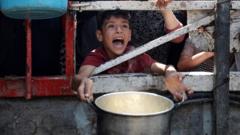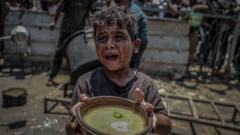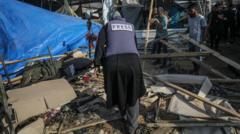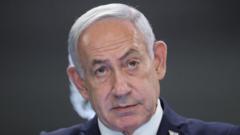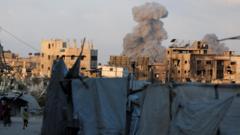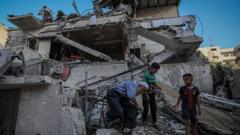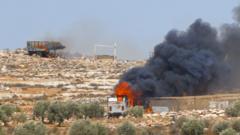In the wake of ongoing violence between Israel and Hamas, shots were reported in central Gaza just hours after Israeli forces announced troop mobilization for territorial expansion. The developing situation follows a night of heavy bombardment and comes amidst an effort for a temporary truce by international mediators, including representatives from the Trump administration.
Tensions Escalate as Gunfire Rings Out in Gaza Amid Israeli Mobilization

Tensions Escalate as Gunfire Rings Out in Gaza Amid Israeli Mobilization
Early morning gunfire in Gaza marks a potential escalation of conflict as the Israeli military prepares for a significant advance into the territory.
As the conflict, which began on October 7, 2023, continues with mounting casualties and humanitarian crises, both sides face challenges in negotiating peace and addressing the desperate conditions in Gaza.
Automatic gunfire erupted early Saturday in the middle of the Gaza Strip, bringing fresh alarm after Israeli military declarations of troop mobilizations aimed at advancing further into the area. Residents in Deir al Balah reported hearing the shots, but uncertainties linger regarding their origin and whether Israeli forces—already controlling significant sections of Gaza—had initiated a new offensive. Multiple requests for clarification from the military went unanswered.
This surge in violence follows a night of significant Israeli airstrikes, and it coincides with diplomatic efforts led by international figures, including from former President Trump, targeting the establishment of a new temporary ceasefire. Since the Israeli-Hamas war erupted on October 7, 2023, the toll has been devastating—Palestinian militant attacks resulted in approximately 1,200 Israeli deaths, with the war claiming over 50,000 lives in Gaza, according to local health officials, who do not differentiate between combatants and civilians in their casualty counts.
Despite the severe human cost, the military campaign has not succeeded in fully incapacitating Hamas or ensuring the release of all hostages. After a ceasefire that lasted two months earlier this year fell apart in March, both sides have ramped up hostilities. Recent airstrikes reportedly killed over 90 individuals in a single day as Israel intensifies operations amid claims of targeting Hamas infrastructure.
The United Nations has raised alarms about the humanitarian crisis unfolding in Gaza. The territory’s two million residents are facing dire shortages of food and medicine, exacerbated by an ongoing blockade that has tightened since March in a bid to weaken Hamas. President Trump acknowledged the grave situation, stating, “a lot of people are starving” in Gaza and indicated U.S. efforts to ease their suffering.
Meanwhile, Hamas has remained firm in its stance, declaring that the fate of the remaining 58 hostages is tethered to Israel’s withdrawal from Gaza and the cessation of combat. Despite Israel’s efforts to eliminate key Hamas leaders, including an operation targeting Muhammad Sinwar, one of its most formidable figures, the group has been able to replenish its ranks.
As the conflict escalates, both sides find themselves locked in a bitter struggle, facing international scrutiny and pressure to resolve the ongoing crisis while humanitarian conditions deteriorate.
Automatic gunfire erupted early Saturday in the middle of the Gaza Strip, bringing fresh alarm after Israeli military declarations of troop mobilizations aimed at advancing further into the area. Residents in Deir al Balah reported hearing the shots, but uncertainties linger regarding their origin and whether Israeli forces—already controlling significant sections of Gaza—had initiated a new offensive. Multiple requests for clarification from the military went unanswered.
This surge in violence follows a night of significant Israeli airstrikes, and it coincides with diplomatic efforts led by international figures, including from former President Trump, targeting the establishment of a new temporary ceasefire. Since the Israeli-Hamas war erupted on October 7, 2023, the toll has been devastating—Palestinian militant attacks resulted in approximately 1,200 Israeli deaths, with the war claiming over 50,000 lives in Gaza, according to local health officials, who do not differentiate between combatants and civilians in their casualty counts.
Despite the severe human cost, the military campaign has not succeeded in fully incapacitating Hamas or ensuring the release of all hostages. After a ceasefire that lasted two months earlier this year fell apart in March, both sides have ramped up hostilities. Recent airstrikes reportedly killed over 90 individuals in a single day as Israel intensifies operations amid claims of targeting Hamas infrastructure.
The United Nations has raised alarms about the humanitarian crisis unfolding in Gaza. The territory’s two million residents are facing dire shortages of food and medicine, exacerbated by an ongoing blockade that has tightened since March in a bid to weaken Hamas. President Trump acknowledged the grave situation, stating, “a lot of people are starving” in Gaza and indicated U.S. efforts to ease their suffering.
Meanwhile, Hamas has remained firm in its stance, declaring that the fate of the remaining 58 hostages is tethered to Israel’s withdrawal from Gaza and the cessation of combat. Despite Israel’s efforts to eliminate key Hamas leaders, including an operation targeting Muhammad Sinwar, one of its most formidable figures, the group has been able to replenish its ranks.
As the conflict escalates, both sides find themselves locked in a bitter struggle, facing international scrutiny and pressure to resolve the ongoing crisis while humanitarian conditions deteriorate.

